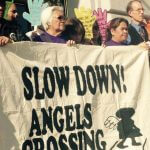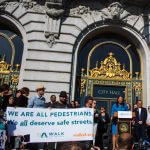Promising new commitments for safe streets
Again and again over the past several weeks, we have said this: there is a crisis on our streets.
Not only have we sounded the alarm at every opportunity, we have advocated for specific actions that Mayor Breed and the City must take to address this crisis. Many of you have spoken out as well, demanding that San Francisco do more – immediately.
Our voices are being heard. And we believe we are moving the needle toward our vision for safe streets for all.
In the past 48 hours, Mayor Breed, Board President Norman Yee, and the SFMTA Board have made demands and commitments that are incredibly promising for getting San Francisco back on track to Vision Zero. Here are the details.
Mayor London Breed issued a powerful directive to SFMTA on near-term safety improvements
We believe quickly installing proven safety fixes using paint and posts on all of our most dangerous streets is how the City can make the biggest life-saving impact now.
On Tuesday morning, Mayor Breed issued a directive to the SFMTA Board that is right in line with this. In it the Mayor asked the SFMTA to move forward with near-term safety improvements on the entire high-injury network without delay. Mayor Breed also asked SFMTA staff for a top-down analysis of all high-injury corridors to ensure the City is prioritizing the most critical projects through a lens of safety, plus for the SFMTA Board develop a strong and comprehensive policy around near-term safety projects.
We are grateful to Mayor Breed for her leadership, especially as we have been asking for greater transparency and accountability with all Vision Zero projects. Mayor Breed also specifically called out the need for near-term safety improvements on 6th Street and Taylor Street, which is critical. Both streets are slated for major safety overhauls (Walk San Francisco successful advocated for bold changes on 6th and Taylor, including travel lane reductions), but construction won’t begin until 2020. The Mayor clearly understands that’s too long to wait to start fixing these deadly streets.
The SFMTA Board of Directors affirmed the Mayor’s directive at their Tuesday meeting and, importantly, put a time frame on it. The newest SFMTA Board member, Amanda Eaken, asked SFMTA’s Livable Streets Director Tom Maguire to return with a 90-day action plan for implementing near-term safety improvements across the high-injury network to be reviewed at the next SFMTA Board meeting on April 2. Yes! Walk SF wants the 100+ streets on the high-injury network to get near-term fixes by 2020.
And more good news: the SFMTA Board also tasked SFMTA staff with studying which streets could be car-free.
Supervisor Norman Yee announced legislation on daylighting, reduced speeds, and Vision Zero metrics
Meanwhile, in addition to Mayor Breed’s directive, Board of Supervisors President Norman Yee announced on Tuesday that he is directing the City Attorney’s office to draft legislation on daylighting, reduced speed limits, and Vision Zero metrics.
The legislation would mandate daylighting citywide. Daylighting improves visibility by moving parking back to a minimum of 10 feet from a crosswalk or intersection; it is a fast, affordable, proven way to make our streets safer for everyone (especially seniors, children, and people with disabilities).
Bringing daylighting to all crossings will undoubtedly save lives, and we applaud Supervisor Yee’s strong stance: “For anyone who says that this will cost parking spaces, let me just respond now: saving lives is more critical than saving a parking space.” We couldn’t agree more.
Supervisor Yee’s legislation also aims to decrease allowable speeds, which is the number one factor in severe and fatal traffic crashes in San Francisco. The legislation will have a limited but important impact in the short-term; long-term, state legislation must be passed to allow San Francisco to fully control speed limits. But the legislation is forward-thinking and gives a boost to broader efforts to control how fast cars and trucks move on our streets.
Lastly, Supervisor Yee’s legislation mandates that the City include severe traffic injuries, not just deaths, as a Vision Zero metric. We were dismayed to see no mention of severe injuries in the City’s new Vision Zero Action Strategy, and relieved Supervisor Yee is immediately on top of this. In 2017, there were close to 575 people severely injured in traffic crashes on our streets, and this figure has not improved in the past seven years the City has been monitoring it. As Yee pointed out, we have a tremendous amount of data from prior collisions that resulted in severe injuries that we can act upon now. We are so grateful to Supervisor Yee for continuing to be such a champion on these issues.
What’s next?
What we saw this week is exactly the kind of urgency and action we need from our elected leaders and agency officials. But of course, this is just the start of what it will take to transform our streets so that everyone – of every age and ability – can get around safely, easily, and affordably.
Here are three ways you can help right now.
- Mark your calendar to join us on the steps of City Hall at our rally on April 10 at 9 AM as part of Walk to Work Day.
- Send an email to our elected officials telling them to act boldly for safe streets.
- Become a member of Walk SF. If you’ve read this far, you clearly care about what’s happening on our streets. We want to count you as a member. The stronger our membership, the stronger our voice can be at City Hall.




